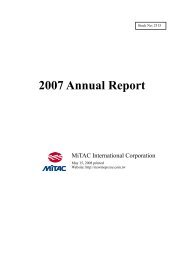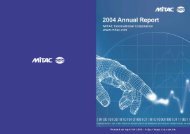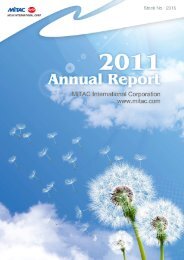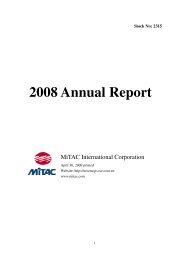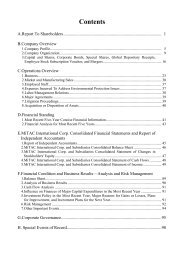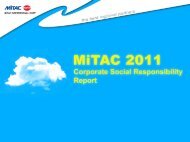Letter To Shareholders - Mitac
Letter To Shareholders - Mitac
Letter To Shareholders - Mitac
Create successful ePaper yourself
Turn your PDF publications into a flip-book with our unique Google optimized e-Paper software.
(c) Short-term financial instruments: Maturities of these financial instruments are<br />
within one year. Therefore, the Group expects to have no significant market risk.<br />
(d) Derivative financial instruments: The forward contract was entered into for<br />
hedging the fluctuation of exchange rate. Gains or losses on this contract is likely<br />
to be offset from the hedged items. Therefore, the market risk is low.<br />
(e) Long-term liabilities of financial instruments: The Group borrows loans, with<br />
floating interest rate. Thus, the Group expects to have no significant market risk.<br />
B. Credit risk<br />
(a) Equity financial instruments: The Group trades with reputable counter-parties.<br />
Thus, there is no significant credit risk.<br />
(b) There are no credit risks in the Group’s bonds payable.<br />
(c) Short-term financial instruments: The Group has established control procedures<br />
over the credit management on counter-parties, and the counter-parties are<br />
reputable companies and financial institutions with high credit ratings. The Group<br />
believes its exposure to potential default risk is low.<br />
(d) Derivative financial instruments: The Group believes its exposure to potential<br />
default risk is low due to the counter-parties being reputable institutions, and the<br />
Group diversifies the credit risks by entering into transactions with multiple<br />
counter-parties.<br />
(e) Long-term liabilities of financial instruments: No credit risk is expected to arise<br />
from the debt instruments.<br />
C. Liquidity risk<br />
(a) Equity financial instruments:<br />
The Group invests in available-for-sale financial assets, which are traded in<br />
active markets and can be readily converted into certain amount of cash<br />
approximate to their fair vaules. The liquidity risk exposure is low.<br />
The Group is exposed to a higher liquidity risk since its investments in financial<br />
assets carried at cost have no active market. However, the Group has no intention<br />
to hold these financial assets for trading and does not expect to sell those<br />
financial assets frequently. Therefore, the exposure to liquidity risk would be<br />
effectively reduced.<br />
(b) Bonds payable:<br />
The Group manages its financing and investing activities based on its operating<br />
capital requirements and capital expenditure budgets, thus, the liquidity risk is<br />
expected to be low.<br />
(c) Short-term financial instruments: Maturities of these financial instruments are<br />
within one year. And the Group has set operating plans to deal with future cash<br />
needs. Thus, liquidity risk is believed to be minimal.<br />
~139~



